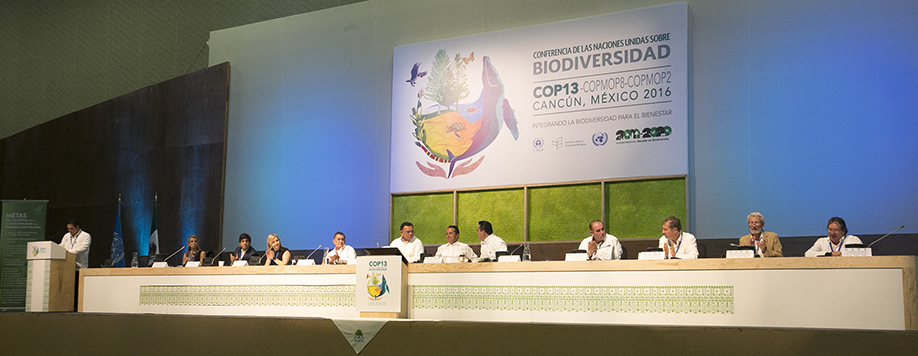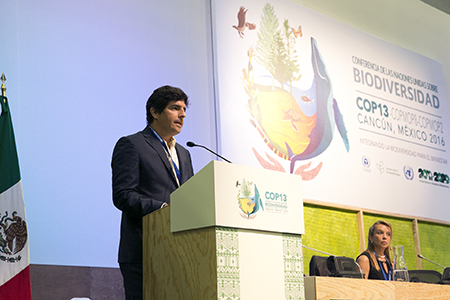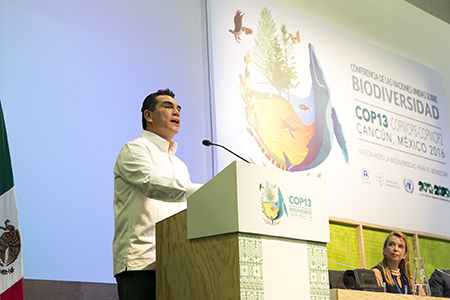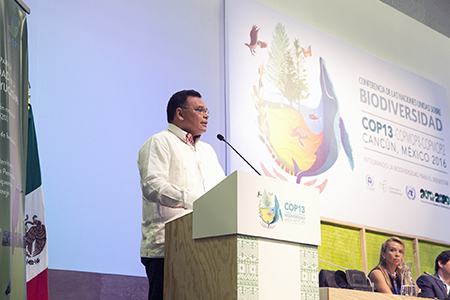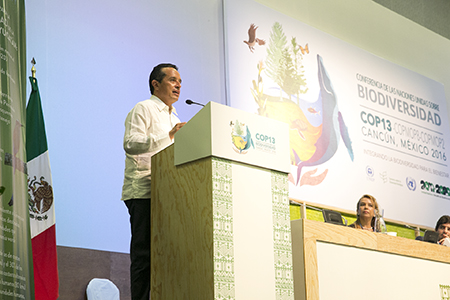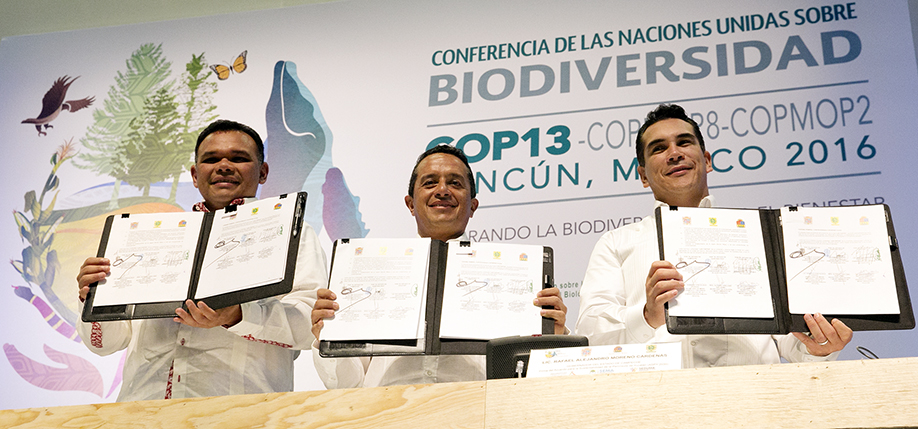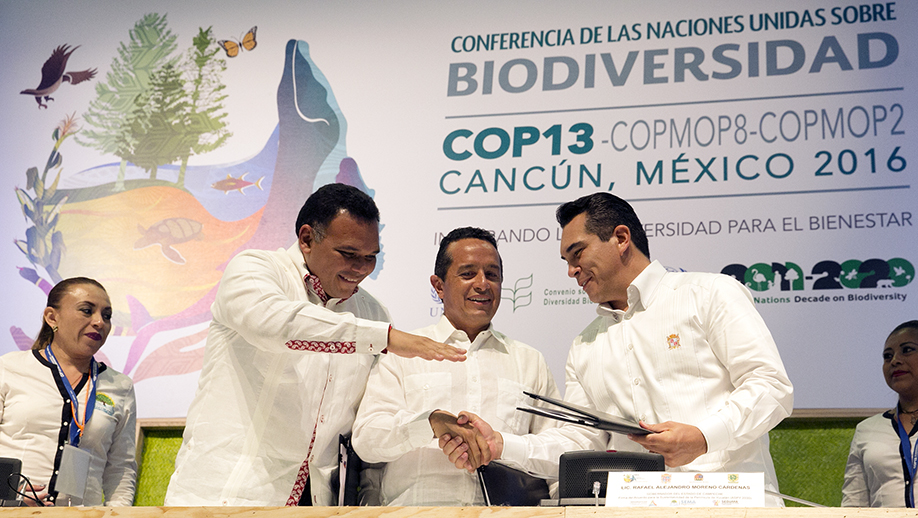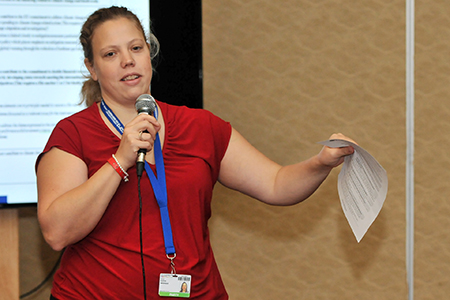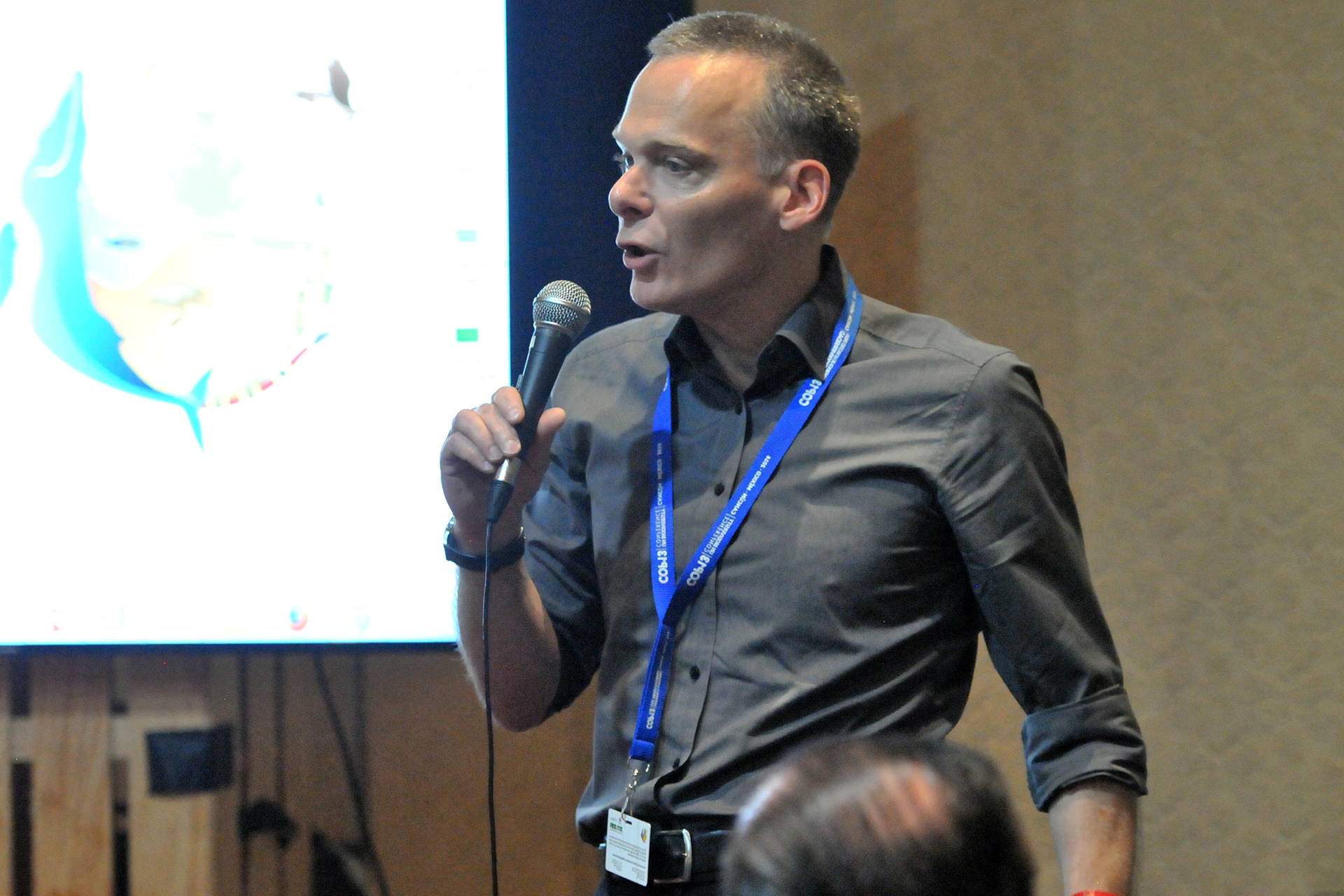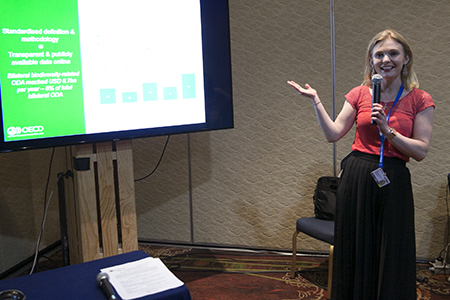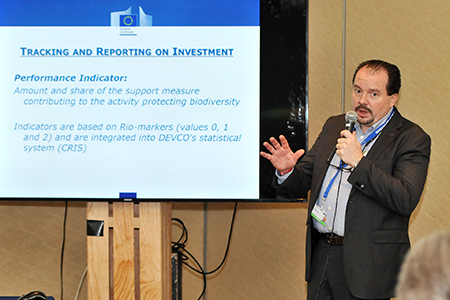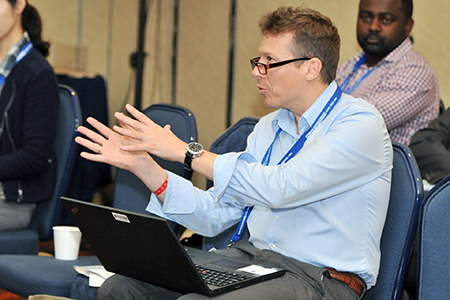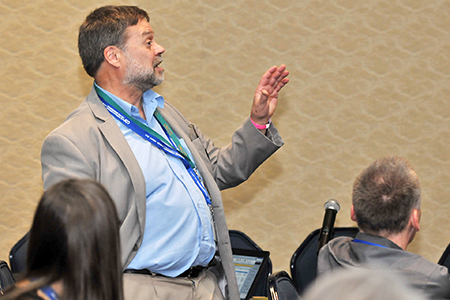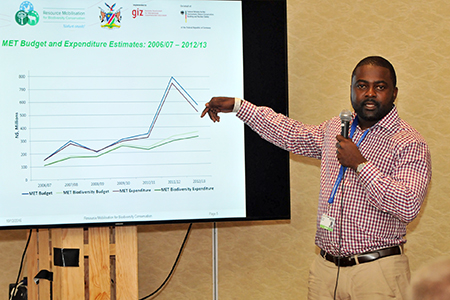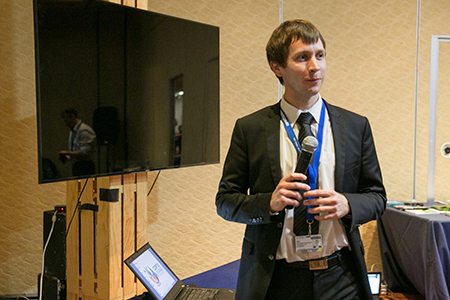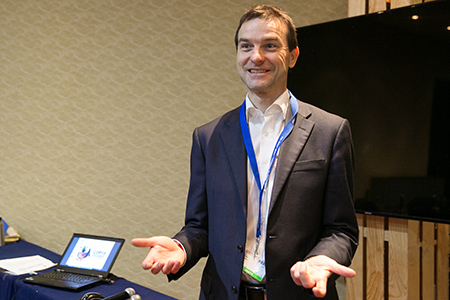Summary
The following event was covered by IISD Reporting Services on Saturday, 10 December 2016:
- Signature and Launch of the Yucatan Peninsula Agreement on Sustainability for 2030 (ASPY)
- Biodiversity-Related Development Finance: Towards Better Tracking
IISD Reporting Services, through its ENBOTS Meeting Coverage, is providing daily web coverage of selected side-events from the UN Biodiversity Conference.
Photos by IISD/ENB | Diego Noguera
For photo reprint permissions, please follow instructions at our Attribution Regulations for Meeting Photo Usage Page.
Signature and Launch of the Yucatan Peninsula Agreement on Sustainability for 2030 (ASPY)
Presented by the Nature Conservancy (TNC), the Mexican REDD+ Programme, and the Latin American Conservation Council (LACC)
At this event, moderated by Antonio Godoy, State of Quintana Roo, the state governments of Campeche, Quintana Roo and Yucatán in Mexico, together with civil society organizations (CSOs) and over 50 companies committed to green growth and conservation of the Yucatán Peninsula by signing the ASPY.
Aurelio Ramos, Director, TNC Latin America, noted the need to increase food production by 2050 due to population increase, stressing that Latin America is central to addressing this challenge. He underscored the need for private-public partnerships to meet the joint challenges of development and conservation, lauding the partnerships represented within the ASPY. He highlighted that the ASPY aims to, inter alia: achieve zero deforestation by 2030; restore two million hectares of degraded lands; and promote Mayan biocultural landscapes on over five million hectares of land.
Rafael Alejandro Moreno Cárdenas, Governor of Campeche, said that the signing represented a step forward in the preservation of the YucatánPeninsula and in biodiversity mainstreaming. Calling the Agreement the “start of the green wave” of Mexico, he stressed that the ASPY will address not only forestry, but also marine and coastal, as well as terrestrial, biodiversity. He highlighted the region’s biocultural heritage, as well as the numerous protected areas, stating that Campeche has the largest mangrove area in the country.
Rolando Zapata Bello, Governor of Yucatán, underscored that the region’s natural wealth is a “treasure,” pointing to the threats posed by climate change. He highlighted that the ASPY is an important strategy for the region and will be essential in achieving zero deforestation, and addressing sustainable consumption and production. He drew attention to Mexico’s commitment to the Paris Agreement and the Cancún Declaration on Mainstreaming Biodiversity, stressing that the Yucatán Peninsula will be central to achieving both these agreements.
In a keynote address, Carlos Manuel Joaquín González, Governor of Quintana Roo, noted that the signing of the ASPY will drive green growth in the Yucatán Peninsula, and announced that this is the first regional agreement on conservation and sustainable growth in Mexico. He stressed that the ASPY is an opportunity to elaborate new green development strategies, and called for the coordination of efforts in order to meet the strategic goals set out in the Agreement, including on agriculture, forestry, fisheries, coastal zone management, ecosystem conservation, water, sustainable markets and sustainable tourism. He welcomed private sector partnerships to attain long-term sustainability represented in the ASPY, expressing confidence that other entrepreneurs and private sector actors will also join the Agreement.
The Governors then signed the ASPY, which consists of two interlinked agreements: the collaboration Agreement between the three states; and the Private Sector Declaration.
The dais during the event
Aurelio Ramos, Director, TNC Latin America, pointed to the ASPY as a tool to attract resources from the global community and the private sector in order to promote green growth in the Yucatán Peninsula.
Rafael Alejandro Moreno Cárdenas, Governor of Campeche, stressed that “we need to leave a better world for our children,” underlining the need for the youth to be involved in the green growth agenda.
Rolando Zapata Bello, Governor of Yucatan, welcomed the ASPY, highlighting that it will make the region attractive to new investments that promote sustainable growth.
Carlos Manuel Joaquín González, Governor of Quintana Roo, promised that he would “restore one coral for each vote,” and called for private investment in green development.
(L-R): Rolando Zapata Bello, Governor of Yucatan, Carlos Manuel Joaquín González, Governor of Quintana Roo, and Rafael Alejandro Moreno Cárdenas, Governor of Campeche, sign the ASPY.
Contact:
- Nadia Peimbert (Coordinator)
| npeimbert@tnc.org
More Information:
Biodiversity-Related Development Finance: Towards Better Tracking
Presented by the Organisation for Economic Co-operation and Development (OECD)
This workshop, moderated by Gabriela Blatter, Federal Office of Environment, Switzerland, engaged participants in discussing current methods of tracking biodiversity-related financing.
Markus Lehmann, Convention on Biological Diversity (CBD) Secretariat, highlighted the challenges faced by parties in meeting the financial mobilization targets, noting that mainstreaming biodiversity into all sectors makes financial reporting difficult, and pointed to the additional challenge on reporting private assistance.
In the first session, on approaches to tracking biodiversity-related development finance, Galina Alova, OECD, presented the Development Assistance Committee (DAC) Creditor Reporting System (CRS) used to monitor development finance targeting the three Rio Conventions. She described the Rio Markers, which are used to capture data to track financing of Rio Conventions’-related activities and goals. She reported bilateral biodiversity-related official development assistance (ODA) of US$8.7 billion in 2014-2015, with the top five contributors being Germany, the US, Japan, France and the EU. In a brief discussion, participants noted difficulties in ensuring data consistency due to the qualitative nature of the Rio Marker.
Luis Antonio Sánchez Perales, Ministry of Environment, Peru, spoke about his country’s approach to tracking biodiversity-related expenditure, stressing that “we must know how much goes to salaries and how much goes to trees and birds.” He presented an online platform where data on both public and private expenditure for biodiversity-related finance can be tracked, noting that an average of US$500 million was spent between 2010 and 2014 on waste management, waste water treatment and in situ conservation of potato breeds.
Bart Missinne, European Commission (EC), highlighted that the EU’s strategy for “biodiversity-proof” development cooperation must ensure that biodiversity is considered in: strategic environmental assessments, to identify and prevent undesired side effects of development projects on biodiversity, and through mitigation measures from development projects; and sector-wide planning, such as for health and infrastructure projects. He demonstrated how the EU has doubled total biodiversity-related ODA to developing countries by 116% against a baseline of average spending from 2006-2010.
Ferdinand Mwapopi, Ministry of Environment and Tourism, Namibia, discussed his country’s experience in tracking national biodiversity expenditure. He cited the use of the UN Development Programme (UNDP) Biodiversity Finance Initiative (BIOFIN) approach for public-private expenditure reviews for biodiversity and costing biodiversity-related projects. He reported progress in disaggregating expenditure data based on sources and activities, noting that biodiversity expenditure was highest in 2010, receiving 2.4% of total government expenditure, and lauded the substantial increase in Germany’s contribution since 2015.
Blatter, on behalf of Eva Mayerhofer, European Investment Bank, spoke on the development of a joint methodology to track biodiversity-related multilateral development finance for multilateral development banks (MDBs). She reported reduced biodiversity-related funding and called on MDB member countries to channel more funding towards biodiversity. She noted that the OECD tracking methodology follows a process-related approach to assess the biodiversity relevance of funding, adding that tracking positive impacts of funding on ecosystem management is preferable to tracking financial flows.
In the second session on how the DAC CRS can be used to track biodiversity-related ODA, Guillaume Simon, OECD, presented a biodiversity-related development finance database of the OECD using three examples of project reporting to illustrate information on, inter alia, donor commitments, project descriptions, timelines and geographic specification. He noted the database uses the Rio Markers to specify whether principal objectives of the project are biodiversity-related. He also said the data could be exported and that a data visualization tool, which illustrates project details, can be accessed at: http://stats.oecd.org
Armida Andres, Biodiversity Management Bureau, the Philippines, discussed her country’s experience, noting concerns on the use of the Rio Markers since most projects do not fall directly in the categories proposed. She recommended feedback mechanisms between donor recipient countries and the CRS to refine these categories and to include differentiation of project implementation at national, subnational and local levels. She noted that tracking biodiversity expenditure is contributing to reporting to National Biodiversity Strategies and Action Plans (NBSAPs). She underscored her country’s preference for its own public expenditure review processes, saying the EU markers were “oversimplified.”
Matthias Krause, Federal Ministry for Economic Cooperation and Development (BMZ), Germany, reported on a BMZ report ‘Committed to Biodiversity,’ which tracks Germany’s international cooperation in support of the CBD. He said bilateral funding is channeled through BMZ and the German Federal Ministry for the Environment, Nature Conservation, Building and Nuclear Safety (BMUB). He noted that the report focuses on international biodiversity finance, which promotes sustainable production and consumption patterns and ensures biodiversity and ecosystem services are taken into account in economic and political decision-making processes.
In a lively two-part discussion, participants discussed, inter alia: the complexities of reporting particularly against the backdrop of mainstreaming biodiversity; the need to ensure that ODA actually benefits biodiversity; the importance of sharing information to avoid overlaps and improve transparency; the role of BIOFIN in reporting; the need to use biodiversity-relevant coefficients to mainstream biodiversity at the national level; and the need to consider biodiversity finance related to private lands. They also spoke about, inter alia: how to account for the difference between what is reflected in project proposals and what is implemented on the ground; how to practically track financing in the achievement of the Aichi Biodiversity Targets; and the danger of basing the ability to achieve all the Targets on Aichi Biodiversity Target 20 (resource mobilization). They also highlighted: the extent of biodiversity-related projects on the database; the importance of assisting recipient countries in using the OECD reporting database; the potential to bridge the gap between the use of datasets in reporting biodiversity-related financing and transparently communicating how this reporting aligns with national commitments for the Rio Conventions; and the use of “commitments” versus “disbursements” in reporting national efforts for biodiversity conservation.
Moderator Gabriela Blatter, Federal Office of Environment, Switzerland
Markus Lehmann, CBD Secretariat, welcomed country perspectives on biodiversity-related financial reporting.
Galina Alova, OECD, said Africa accounted for the highest share of bilateral biodiversity-related ODA commitments in 2014-15, amounting to 31%.
Luis Antonio Sánchez Perales, Ministry of Environment, Peru, noted that “it is not how much we spend on biodiversity, but what we do with the funding.”
Bart Missinne, EC, described how the EU uses performance indicators to track and report on biodiversity investment.
Grégoire Dubois, EC, during ensuing discussions.
Matti Nummelin, Ministry of Foreign Affairs, Finland
Ferdinand Mwapopi, Ministry of Environment and Tourism, Namibia, said Namibia has been tracking biodiversity-related funding since 2006.
Guillaume Simon, OECD Development Co-operation Directorate, described the content of an online database to track biodiversity-related development finance.
Matthias Krause, BMZ, said that since 2012, projects that include the Rio Markers are considered in a country’s biodiversity-related bilateral financing.
Contact:
- Galina Alova (Coordinator)
| Galina.Alova@oecd.org
- Nicolina Lamhauge (Coordinator)
| Nicolina.Lamhauge@oecd.org

